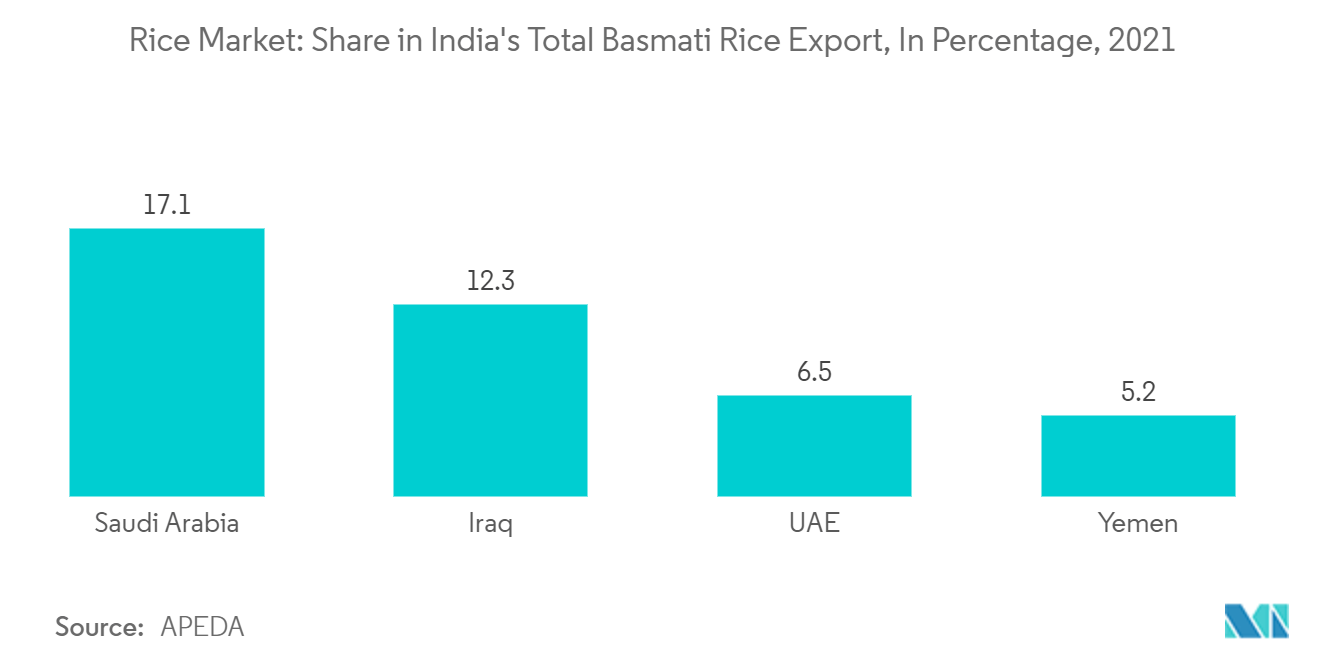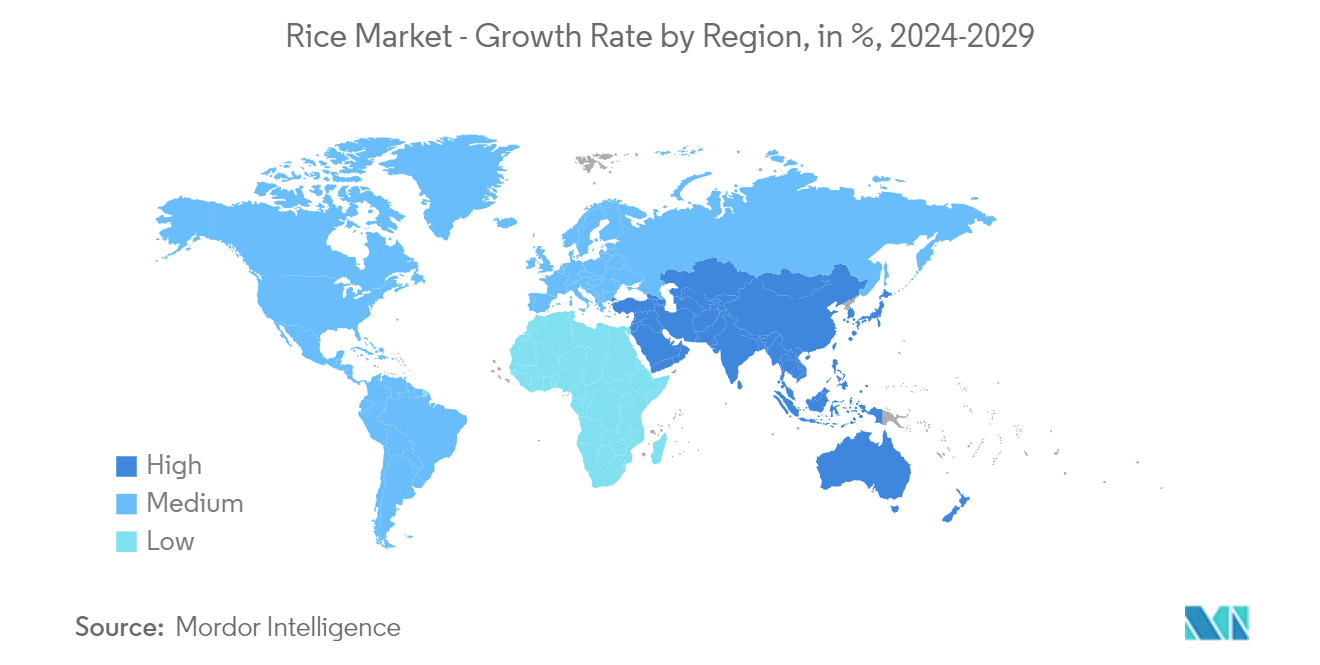Market Trends of Rice Industry
Growing preference for specialty rice varieties leads to increased trade
The demand for specialty rice has been gaining traction globally, bolstered by consumers' growing concerns about health and wellness. Compared with regular milled white rice, specialty rice varieties are rich in vitamins and minerals, aid good health, and are good sources of fiber. Therefore, such varieties are witnessing an immense demand among consumers.
Around the world, basmati rice is one of the best types of rice. It is known for its slender, sleek, tapering grains with a unique taste, aroma, and grain elongation quality upon cooking. Exports of the premium variety from India have an 85% share in the basmati export market. The United States imports Asian aromatic rice, such as jasmine and basmati. India is the top exporter of basmati rice to the global market. According to the Agricultural and Processed Food Products Export Development Authority (APEDA), the country exported 3,948,161.03 metric tons of basmati rice to the world for the worth of USD 3,540.40 million during the year 2021-22. In 2021, Saudi Arabia, Iran, Iraq, the United States, and the United Arab Emirates were the major importers of basmati rice.
In 2021, China, the Philippines, the Kingdom of Saudi Arabia, the United States, Bangladesh, and Iraq were the major importers of rice globally. China and the Philippines account for 45% of the rice imports at the global level. India exports huge volumes of aromatic and long-grain basmati rice, which is anticipated to increase with tourism and changes in food patterns. Port handling infrastructure, the value chain development, and exploring new opportunities in countries or markets for rice exports led to a huge spike in rice exports.
In Europe, the demand for specialty and exotic varieties, such as basmati as well as jasmine rice, is growing exponentially. A significant share of imported rice consists of long-grain Indica rice and aromatic varieties (basmati and jasmine), which are popular mainly in Northern Europe. The United Kingdom dominates the imports of basmati rice, mainly from India.
Furthermore, black rice, also known as forbidden rice, an antioxidant-rich variety, has become an exotic staple, which is quickly gaining popularity in North America. The Boston-based Whole Grains Council refers to another study on its site from a team of researchers at the Cornell University, who found that antioxidants were about six times higher in black rice than in common brown and white rice. Thus, the rising demand for different specialty varieties of rice has been significantly bolstering the growth of the rice market across the globe.

Asia-Pacific is the Largest Region
Rice is the staple food of Asia and part of the Pacific. According to the Food and Agriculture Organization, about 90% of the global rice is produced and consumed in Asia. India and China are the prominent producers of rice, with a production of 177.6 million metric tons and 211.4 million metric ton, respectively, in 2020.
Over the ages, China has dominated production and continues to do so. All rice cultivation is highly labor-intensive. Rice farms are mainly located in Central China, accounting for about 49% of Chinese rice production (National Bureau of Statistics of China). Apart from meeting its huge domestic demand, China also exports a significant quantity of rice globally. Major importers of Chinese rice are Ivory Coast, Korea, Egypt, Turkey, and Japan. Rice production will likely remain high during the forecast period, given the high local consumption and global export demands.
Likewise, rice production in India has increased by 3.5 times in the last 60 years. According to the Rice Exporters Association, Indian rice exports touched 20 million tons in 2021, as well as 16 million tons of non-basmati rice. Rice being vital, no country-enforced restrictions on its import. Furthermore, the Indian government has been helping farmers to take up rice cultivation by providing a minimum support price (MSP). For the 2021-2022 Kharif season, the minimum selling price (MSP) was INR 1,940 per quintal compared to INR 1,868 per quintal in 2021.
Rice is highly water intensive crop in India. As a result, various state government are investing on more sustainable method for production. For instance, in 2021 under the umbrella scheme for agriculture development in the country, Rastriya Krishi Vikas Yojna (RKVY) Haryana government initiated direct seeded rice technique, which consume about 15-20% less water than the traditional technique in the country. Farmers following this technique were awarded USD 67.4 per acre. This initiative is anticipated to improve the sustainable production of rice in the country.
In addition, Indonesian Bureau of Logistics (BULOG) manages state interventions in the domestic market and imports, as well as market activities aimed at stabilizing domestic prices and the government rice reserve. BULOG acquire paddy or rice from farmers if the market price is less than or equal to the minimum price, and it must keep a minimum year-end stock of 2 million metric tons, or around 2.5 % of Indonesia's annual rice consumption. Government procuring rice in market failure conditions, encourage farmers for increased production.
After China and India, Indonesia, Bangladesh, Vietnam, and Thailand were the next largest rice producers. Thus, owing to increasing demand and government initiatives to increase rice production, the market is anticipated to grow during the coming year.


